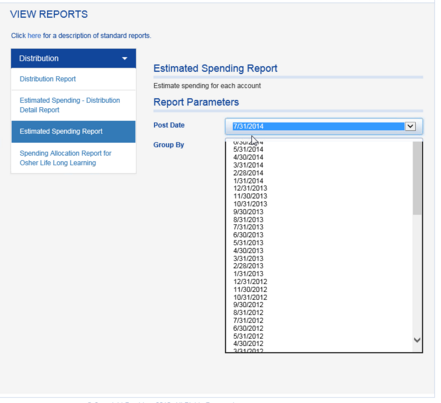This article will help explain how Fundriver handles spending distributions and options for client set up. It will also provide recommendations for handling different distribution configurations. There is a file at the bottom of the article that shows examples.
The distributions data is initially imported as part of the initial data load via the Distribution Rules tab on the Data Load Template. Additional rules can be set up as funds are created.
Distributions are set up by fund through the ORGANIZE tab (if they weren't set up during your software implementation).
Initial client distribution information (that requires special handling by Support) is uploaded on the Distribution Rules tab of the Data Load Template. Only funds that have split distributions, donor-directed reinvestment, or special exceptions (such as fixed amount rules) should be listed on the distribution rules tab.

Once loaded, distribution information can be added or edited on the FUND PROFILE. Click on FUNDS to get a full fund list and then click on (or search for) an individual fund name to access the FUND PROFILE.
DISTRIBUTION ACCOUNT is located directly under the FUND PROFILE section for a specific fund.

In this view the FUND PROFILE is collapsed, as are the DISTRIBUTION ACCOUNT and DOCUMENTS sections. To expand, click on the white arrow on the right side of the section.
To set up a REINVEST THRESHOLD, enter a dollar amount in the field below. You can also set an authorize date, if one has been specified in the donor agreement or as board spending policy (for example, a fund may need to accumulate 3 years of appreciation prior to spending). The reinvest threshold will determine if spending can occur, if populated and a fund meets the threshold it will begin participating in spending (if it has been assigned a spending rule).
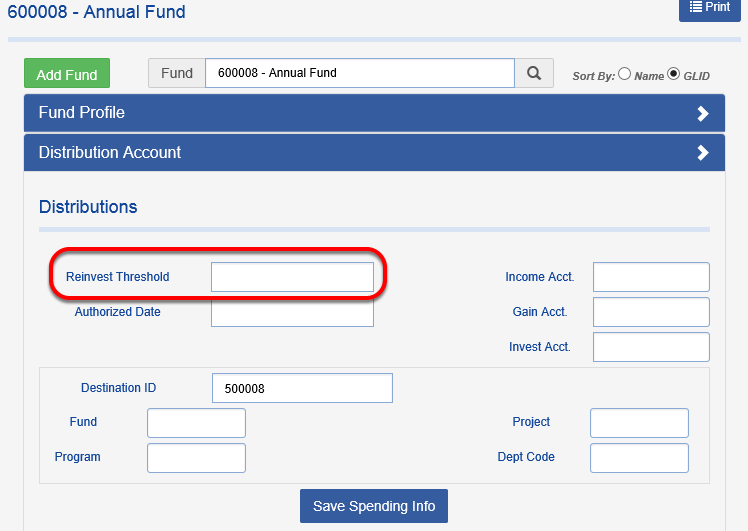
If a fund has an AUTHORIZE DATE, the fund is not able to make distributions until that date has passed.

The program default uses the current posting period as the date to compare to the authorize date. If the current posting period is greater than the authorize date, the fund is eligible to make distributions.
If your database is set up with the OLD Spending interface, and a fund has both an Authorize Date and a Reinvest Threshold set, then by Default the fund will only need to meet one condition for spending to occur. If your database is set up with the NEW Spending interface, and a fund has both an Authorize Date and a Reinvest Threshold set, then by Default the fund will need to meet BOTH conditions for spending to occur. Contact Support if you need more info on this function!
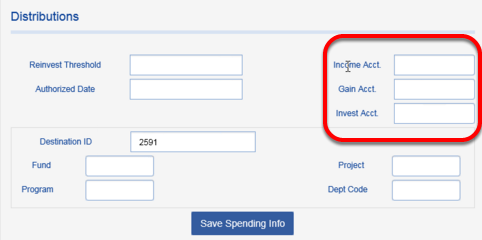
The DESTINATION ID field is used to house the spending account number where the distributions are transferred as income for spending.

On the FUND PROFILE, click on ADD DIST. RULE button to set up distribution rules. This is located on the bottom of the Distribution Account screen.
There are four choices available. See below for examples of how to use each ACTIVITY TYPE.

Definitions of ACTIVITY TYPE:
Distribute - Distributes all earnings based on Spending Rule applied. A distribution transaction entry is posted.
Reinvest to Market - An external transfer in transaction is posted. Records as a transfer. Increases temporarily restricted as long as fund is above water.
Reinvest to Principal - Impacts cost and gets recorded as a gift. Impacts permanently restricted net asset. An Income to Principal transaction is posted.
Add to Unspent Allocation - Fund accumulates spending in a bucket. Does not impact cash until it is spent. Does not get reset each year; the cash builds up. A Spending Bucket Transfer transaction is posted.
Below are 6 examples of different distribution rules and how their application affects distributions. The examples will explain how the fields in the screen capture below should be populated in each scenario. Check out the attached spreadsheet at the conclusion of this article for more examples!
Example 1: Making a simple distribution for the full amount
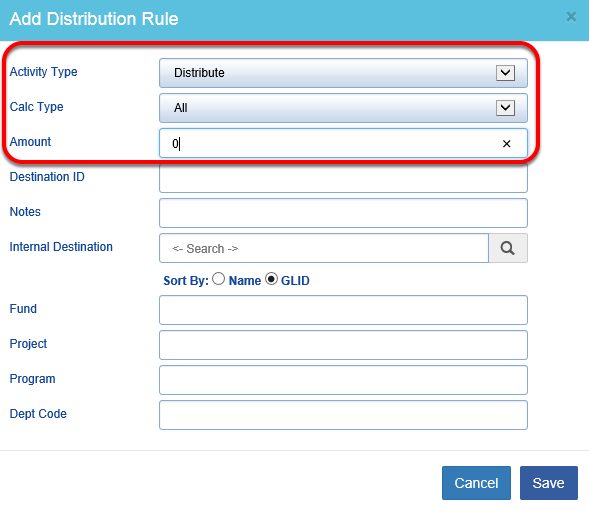
- Click the add button
- Select Distribute as ACTIVITY TYPE
- Select All as CALC TYPE (the system ignores the amount)
- Optional: Enter a note and a Destination ID or internal account
Cash flow impact: Cash flow out of the pool for the amount of the distribution.
Example 2: Making a distribution for a partial amount (in this example, we will be distributing 50% of the calculated amount and the rest will remain in the fund). Enter a percentage amount as a whole number. For example, 50% should be entered as “50” not “.5”.

- The spending formula results in a $500 calculated distributable amount.
- User enters item in the distribution screen to distribute 50% of the allocation.
Result: Distribution created for half of the calculated distributable amount. Fundriver will only create a distribution transaction for 50%, leaving the rest in the fund/pool.
Cash flow impact: Cash flow out of the pool $250
Example 3: How to reinvest a percentage of the distribution (You will need to create two distribution entries.)
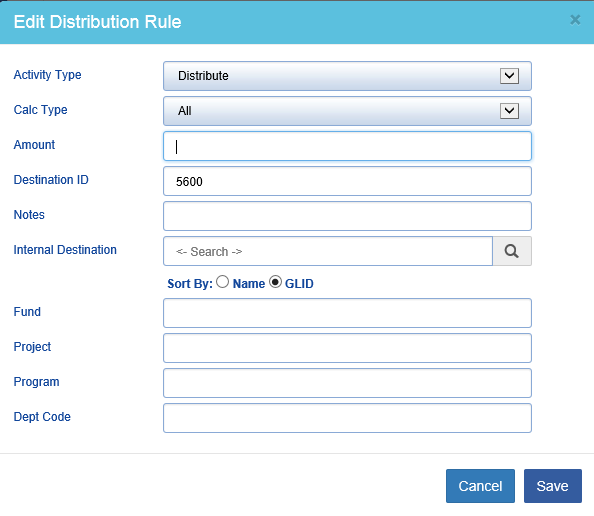
First, make an entry in the distribution grid for a distribution of the full amount.
- Click the add button
- Select Distribute ACTIVITY TYPE
- Select All CALCULATION TYPE (the system ignores the amount)
- Optional: Enter a note and a Destination ID or internal account
- SAVE.
Create a second entry to tell the program to reinvest a percentage of the earnings back to principal.

Make a second entry for the amount to reinvest
- Click the ADD button
- Select Reinvest to Principal ACTIVITY TYPE
- Select Percentage CALCULATION TYPE
- Enter the percentage you want to distribute in the amount cell
Note: Be sure to enter percentage as a whole number.Assume the spending formula results in a $500 calculated distributable amount.
Result: Two transactions are created:
1. A distribution transaction for the full calculated distributable amount ($500)
2. A reinvestment transaction for 25% of the calculated distributable amount ($125).
Cash flow impact: The net cash flow on the reconciliation will be a cash flow out for the remaining 75% of the calculated distributable amount ($375).
Example 4: How to distribute a fixed amount
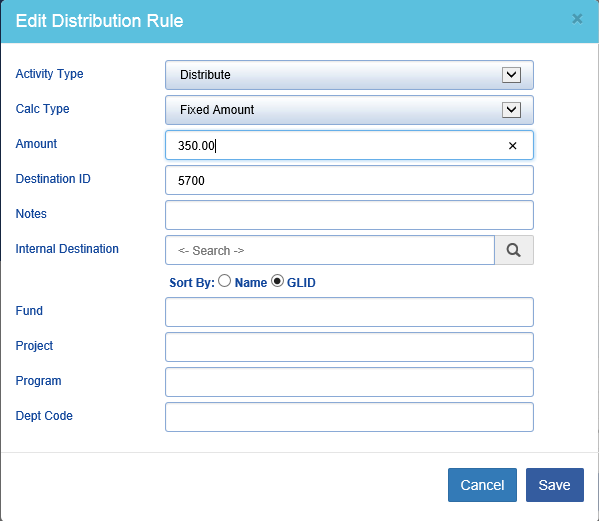
Make an entry in the distribution screen for a distribution of a fixed amount.
- Click the add button
- Select Distribute ACTIVITY TYPE
- Select Fixed Amount CALCULATION TYPE
- Enter the amount you want to distribute in the amount cell
Optional: Enter a note and a Destination ID or internal account.
Result: A single distribution transaction will be created for the fixed amount.
If you are set up with the New Spending interface, enter the annualized fixed amount. If you are set up on the Old Spending Interface, enter the amount you want to post each period (if you post monthly, enter the monthly amount; if quarterly, enter the quarterly amount, etc.)
Example 5: What happens if there is no entry in the distribution grid?
Result: The system creates a distribution based on the fund's assigned Spending Rule (via the Fund Profile Section).
Example 6: How to retain the entire distributed amount as undistributed income

Make an entry in the distribution grid for a distribution of the full amount.
- Click the add ADD button
- Select Unspent Distributions ACTIVITY TYPE
- Select CALC TYPE of ALL (the system ignores the amount)
- Optional: Enter a note and a Destination ID or internal account
Net cash flow impact: None
Note: Reinvest rules only work if there is a DISTRIBUTION RULE set up. Destination ID, Fund, Project all need to be added to rule if that information is needed on the transaction record.
Other things to note when setting up distributions:
If a client's setup has distribution activity impacting unit price rather than units, all funds in that pool need to participate in the same spending rule. If not, all funds participate in the spending, then this unequal distribution will be shown in unrealized gain (loss) allocation.
If a client has an AUTHORIZE DATE and REINVEST THRESHOLD populated and the AUTHORIZE DATE criteria has been met, that overrides the REINVEST THRESHOLD criteria.
A client's REINVEST THRESHOLD is based on historic gift. Fundriver can customize this option to be based on pooled market value.
When setting up a CALC TYPE of Percentage, setting up two rules (one as a Distribute ALL and one as your percentage) will ensure that all pennies are accounted for. Setting up two percentage rules (ex. 50% and 50%) might overlook pennies due to rounding.
All of the fields in the box below will pull onto the transaction record when the distributions are processed.

The automated process is done through ACTIVITY DISTRIBUTE.
If distributions are going to two or more destinations, multiple rules will need to be set up.
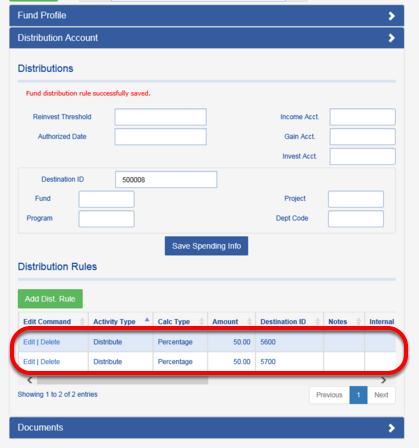
For fixed amount rule, you want to set up a distribute all and then the fixed amount to make sure the entire distribution is accounted for. If you only did fixed amount it would just pull that amount, and not apply the full distribution amount.
To check to make sure distributions processed properly, run the DISTRIBUTION ESTIMATED SPENDING REPORT.
If you are set up with the New Spending interface, the reports are located in the SPENDING reports suite.
